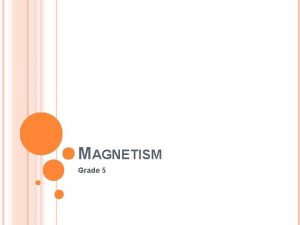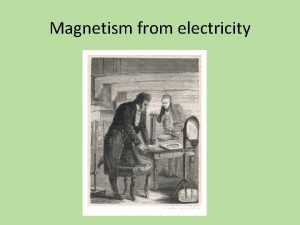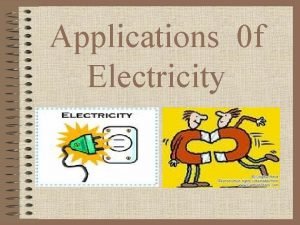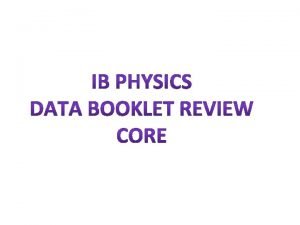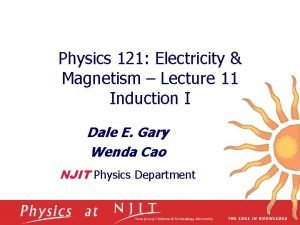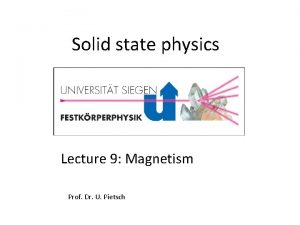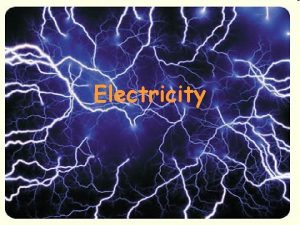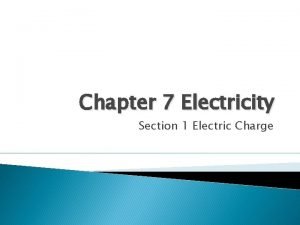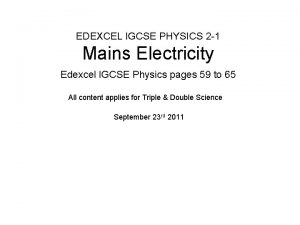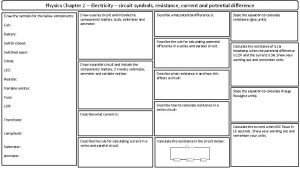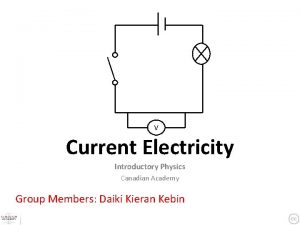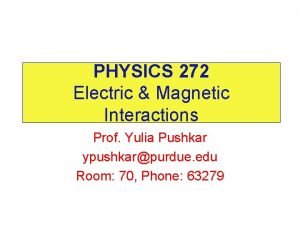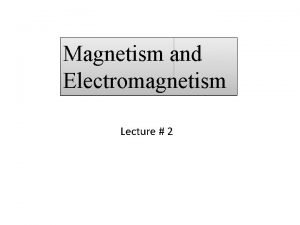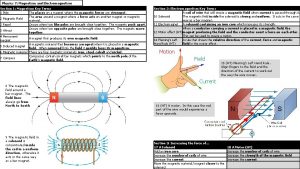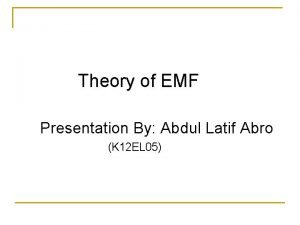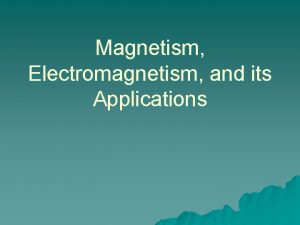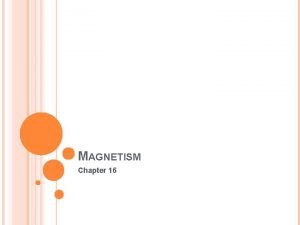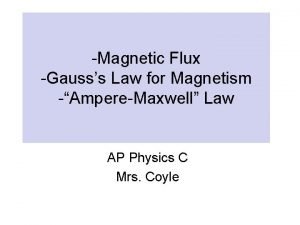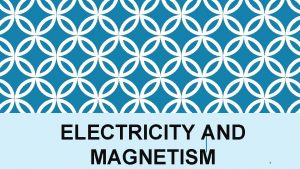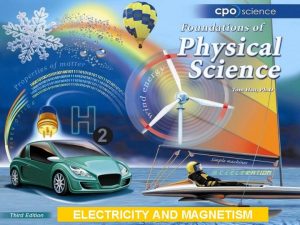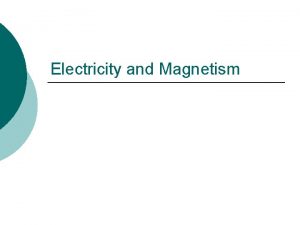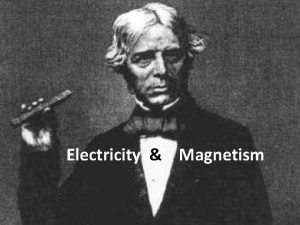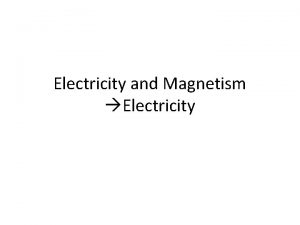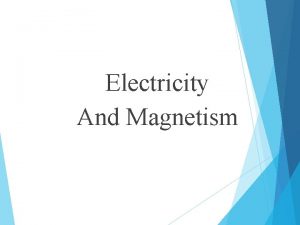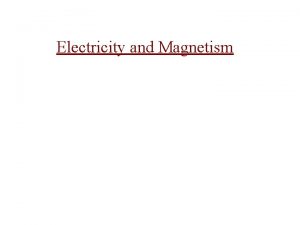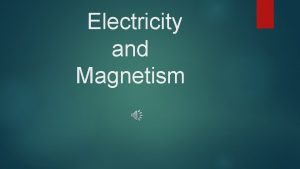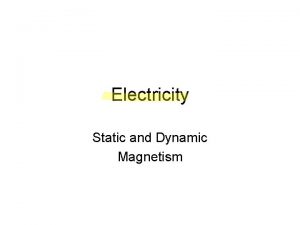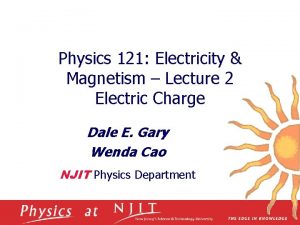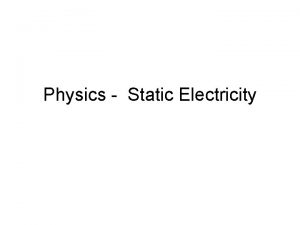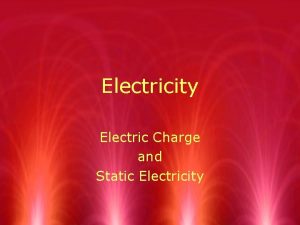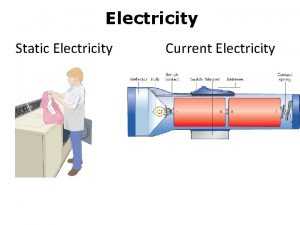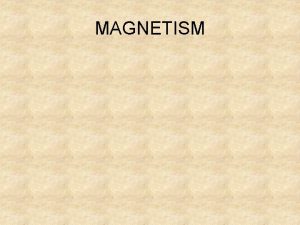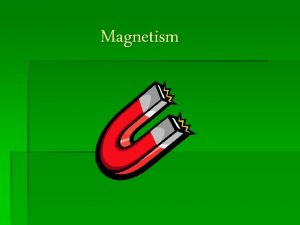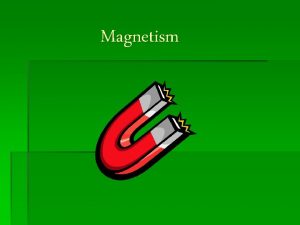Physics 104 Electricity and Magnetism Lecture 1 Charge








































- Slides: 40

Physics 104 Electricity and Magnetism Lecture 1 Charge and Coulomb’s Law

The History of Electricity Electric elektron = Greek word for amber “Rub amber with wool, and it will pick up bits of wood, feathers, straw …” Thales of Miletus (640 -546 BC) About 1736, Charles Francois du Fay (1698 -1739) learned that rubbing glass and rubbing resinous substances (e. g. , amber) seemed to produce charges of different kinds. He found that two charges of the same kind repelled each other, while two of unlike kinds attracted. He suggested that electricity might exist as two distinctly different types, which he named “vitreous” and “resinous” electricity. William Watson (1715 -1790) suggested in 1746 that electricity was one “fluid”. One of the two kind of electricity proposed by Du Fay could be an excess ( ) of this fluid and the other a difficiency of it ( ). Flow from to could account for electrical discharge. Benjamin Franklin (1706 -1790) adopted and popularized Watson's “one fluid” theory and chose vitreous electricity to be the positive type (thereby giving electrons a negative charge). Franklin’s great reputation won universal acceptance for this view. 5/25/2021 Physics 104 - Lecture 1

Charging Experiments (1) 1 Observations: 2 1. No force is observed between un-rubbed rods. 2. Plastic rods rubbed with wool repel each other. 3 3. Glass rod rubbed with silk attracts plastic rod rubbed with wool. 4. At increased distance, forces are decreased. 5/25/2021 Physics 104 - Lecture 1 4

Charging Experiments (2) 1 2 3 More Observations: 1. A (charged) plastic rod rubbed with wool attracts small pieces of paper. 2. A (charged) plastic rods rubbed with wool is attracted to an un-rubbed (neutral) plastic rod. 3. A plastic rod rubbed with wood is attracted to the wool, repelled by the silk. 4. No charged (rubbed) object attracts both the charged plastic rod and the charged glass rod. 4 5/25/2021 Physics 104 - Lecture 1

Electric Charge and Atoms An atom with atomic number Z consists of a small but massive nucleus of charge Ze, surrounded by a cloud of Z electrons, each with much less mass and with a charge of e. The atom has a diameter of about 10 10 m (0. 1 nm), while the atomic nucleus has a diameter of about 5 x 10 15 m (5 fm). All atoms, heavy or light, are about the same size, but the mass varies from 1 to ~250. The nucleus contains Z protons with charge e and N neutrons with charge 0. The atomic mass number of the atom is A = Z+N. Charge: q = Npe Nee = (Np Ne)e ; for neutral atoms (q=0), Np=Ne=Z 5/25/2021 Physics 104 - Lecture 1

Positive and Negative Ions Atoms can have a net charge if Np Ne, where Np Z is the number of protons and Ne is the number of electrons in the atom. If a neutral atom loses one electron, it will have a net positive charge of q e because Np Ne= 1. If a neutral atom gains one electron, it will have a net negative charge of q= e because Np Ne= 1. 5/25/2021 Physics 104 - Lecture 1

Charging by Friction causes the breaking of molecular bonds, and can result in a separation of charges in a formerly neutral molecule, creating a positive and a negative molecular ion. Rubbing a plastic rod with wool or a glass rod with silk produces such charge separation effects. 5/25/2021 Physics 104 - Lecture 1

Conservation of Charge Electrical charge can be neither created or destroyed. It can be separated and moved around, but the net charge of an isolated system must remain constant. qinitial qfinal Example: A plastic rod is rubbed with wool, each initially neutral. Then qwool=-qrod. 5/25/2021 Physics 104 - Lecture 1

The Electroscope 5/25/2021 Physics 104 - Lecture 1

Charging an Electroscope The angle of deflection of the leaves provides a rough indication of the amount of charge that has been deposited on the electroscope. 5/25/2021 Physics 104 - Lecture 1

Discharging a Charged Object The human body, composed mainly of salty water, is a moderately good conductor. Therefore, a person touching a charged object will normally discharge the object. Where the charge goes next depends on the degree to which the person is insulated from ground (e. g. , by rubber shoe soles). 5/25/2021 Physics 104 - Lecture 1

Charges and Forces 5/25/2021 Physics 104 - Lecture 1

The Electric Dipole Experiment: Bring a positive charge near a neutral atom. 5/25/2021 Physics 104 - Lecture 1

Coulomb’s Law Like charges repel. Charles Augustine de Coulomb (1736 -1806). Opposite charges attract. Coulomb’s Law: 5/25/2021 ( Magnitude of force ) Physics 104 - Lecture 1

Units of Charge Coulomb’s Law, written two ways. (Note that in Newton’s law of gravitation, G, which plays a role similar to K, has the value G = 6. 67 10 -11 N m 2/kg 2. ) 5/25/2021 Physics 104 - Lecture 1

Using Coulomb’s Law 1. Coulomb’s Law applies only to point charges. (This is particularly important because charge are free to move around on conductors. ) 1. Strictly speaking, Coulomb’s Law applies only to electrostatics (non-moving charges). (However, it is usually OK provided v<<c). 1. Electrostatic forces can be superposed. Linear superposition !!!! 5/25/2021 Physics 104 - Lecture 1

Example: Sum of Two Forces Two +10 n. C charged particles are 2 cm apart on the x axis. (1) What is the net force on a +1. 0 n. C particle midway between them? (2) What is the net force if the charged particle on the right is replaced by a -10 n. C charge? 9 -9 5/25/2021 Physics 104 - Lecture 1

Example: Point of Zero Force Two positively charged particles q 1 and q 2=3 q 1 are placed 10. 0 cm apart. Where (other than infinity) could another charge q 3 be placed so as to experience no net force? Need force vectors to be co-linear, so location must be on x axis. Need force vectors to be in opposite directions, so location must be between 0 and d. Need force vectors equal in magnitude, so F=Kq 1 q 3/x 2=Kq 2 q 3/(d-x)2. Therefore, (d-x)2=3 x 2 or x=d/(1±√ 3) = 10 cm/(1± 1. 732); x+=10. 0 cm/2. 732 = 3. 66 cm; x-=10. 0 cm/-0. 732= 13. 66 cm, which does not satisfy the 2 nd criterion. 5/25/2021 Physics 104 - Lecture 1

Example: Three Charges (1) Three charges with q 1 = -50 n. C, q 2 = +50 n. C, and q 3 = +30 n. C, are placed at the corners of a 10 cm x 5 cm rectangle as shown. What is the net force on q 3 due to the other two charges? 5/25/2021 Physics 104 - Lecture 1

Example: Three Charges (2) Cos 5/25/2021 Sin Physics 104 - Lecture 1

Example: Lifting a Glass Bead A small plastic sphere is charged to -10 n. C. It is held 1. 0 cm above a small glass bead that rests on a table. The bead has a mass of 15 mg and a charge of +10 n. C. Will the glass bead “leap up” to the plastic sphere? Therefore, F 1 on 2 exceeds w by a factor of 60. Therefore, the sphere should indeed leap upward. (Note that we have neglected electrical forces between the bead and table, which could be significant. ) 5/25/2021 Physics 104 - Lecture 1

Fields: Fields 1. The electric field permeates all of space 2. Charges interact with the electric field inducing a non-zero value of E (subject to boundary conditions). 3. A charge in an electric field experiences a force F exerted by the field. 3. This relation assigns a field vector to every point in space. 4. If q is positive, the electric field vector points in the same direction as the force vector. 5. Does E depend on q (the charge that detects it)? No, because the force is proportional to q. 5/25/2021 Physics 104 - Lecture 1

Question An electron (q = e, m = me) is placed at the position shown by the black dot. The force on the electron is: (a) Zero. (b) To the right. (c) To the left. (d) Insufficient information to tell. 5/25/2021 Physics 104 - Lecture 1

The Electric Field of a Point Charge 5/25/2021 Physics 104 - Lecture 1

Electric Field Diagrams Points about field diagrams: 1. The diagram is only a representative sample of the electric field. The field exists at all points in space. 2. The arrow indicates the direction and strength of the field at the point to which the vector tail is attached. The length of the vector is a relative measure of the field strength. 3. The electric field is not a quantity that ``stretches’’ from one point to another. Each vector represents the field at that one point in space. 5/25/2021 Physics 104 - Lecture 1

Unit Vector Notation Positive q 5/25/2021 Physics 104 - Lecture 1 Negative q

Field Map vs. Field Lines Field lines start on positive charges. Q Field lines stop on negative charges. -Q More charge more field lines. 2 Q weak strong Field lines never cross. 5/25/2021 Physics 122 B - Lecture 3 27

A Prelude to Maxwell’s Equations Suppose you come across a vector field that looks something like this. What are the identifiable structures in this field? 1. An “outflow” structure: 2. An “inflow” structure: 3. An “clockwise circulation” structure: 4. An “counterclockwise circulation” structure: Maxwell’s Equations will tell us that the “flow” structures are charges (+ and -) and the “circulation” structures …. we will come back to this later…do no occur in static situations 5/25/2021 Physics 122 B - Lecture 3 28

The Dipole Field Map 5/25/2021 Field Lines Physics 122 B - Lecture 3 29

Two Positive Charges Field Map 5/25/2021 Field Lines Physics 122 B - Lecture 3 30

Example: Calculating the Electric Field A 1. 0 n. C charged particle is located at the origin. Points 1, 2, and 3 have (x, y) coordinates in cm of (1, 0), (0, 1), and (1, 1), respectively. Determine the electric field E at each of these points. 5/25/2021 Physics 104 - Lecture 1

5/25/2021

Example: The Electric Field of a Proton In a hydrogen atom, the electron orbits the proton at a radius of 0. 053 nm. Both have charges of magnitude e = 1. 60 x 10 -19 C. (a) What is the proton’s electric field strength at the position of the electron? (b) What is the magnitude of the electric force on the electron? 5/25/2021 Physics 104 - Lecture 1

Question 2 Which system has the largest electric field at the location of the numbered point? (a) 5/25/2021 (b) (c) Physics 104 - Lecture 1 (d)

Motion of a Charged Particle in an Electric Field In an electric field, does a charged particle follow the field lines? NO! Only a massless charged particle would follow the field lines. 5/25/2021 Physics 122 B - Lecture 4 35

Example: An electron moving across a capacitor Two 6. 0 cm diameter electrodes are spaced 5. 0 mm apart. They are charged by transferring 1. 0 x 1011 electrons from one electrode to the other. A electron is released from rest at the surface of the negative electrode. How long does it take the electron to cross to the positive electrode? Assume the space between the electrodes is a vacuum. 5/25/2021 Physics 122 B - Lecture 4 36

Example: Deflecting an electron beam An “electron gun” creates a beam of electrons moving horizontally with a speed vx = 3. 34 x 107 m/s. The electrons enter a 2. 0 cm long gap between two parallel electrodes producing a downward electric field of E = 5. 0 x 104 N/C. In what direction and by what angle is the electron beam deflected? The deflection is upward because the negatively charged electron experiences a force in the opposite direction from E. 5/25/2021 Physics 122 B - Lecture 4 37

Summary: 5/25/2021 Physics 104 - Lecture 1 (1)

Summary: (2) 5/25/2021 Physics 104 - Lecture 1

Typical Electric Field Strengths 5/25/2021 Physics 104 - Lecture 1
 Magnetism
Magnetism Physics 102
Physics 102 Topic 5 ib physics
Topic 5 ib physics Electricity and magnetism jeopardy
Electricity and magnetism jeopardy Sph3u electricity and magnetism
Sph3u electricity and magnetism Electromagnet experiment hypothesis
Electromagnet experiment hypothesis Magnetism and electricity
Magnetism and electricity Magnetism grade 5
Magnetism grade 5 Electricity and magnetism
Electricity and magnetism Electric fuse and circuit breaker graphic organizer
Electric fuse and circuit breaker graphic organizer Ampere
Ampere Electricity and magnetism
Electricity and magnetism Electricity and magnetism
Electricity and magnetism How are static electricity and current electricity alike
How are static electricity and current electricity alike Static electricity and current electricity
Static electricity and current electricity Electricity n
Electricity n Magnetism
Magnetism Chapter 24 magnetism magnetic fundamentals answers
Chapter 24 magnetism magnetic fundamentals answers Chapter 6 electricity section 1 electric charge answers
Chapter 6 electricity section 1 electric charge answers Electricity section 1 electric charge
Electricity section 1 electric charge Electricity section 1 electric charge
Electricity section 1 electric charge Circuit breaker igcse
Circuit breaker igcse 01:640:244 lecture notes - lecture 15: plat, idah, farad
01:640:244 lecture notes - lecture 15: plat, idah, farad Difference between charge and electric charge
Difference between charge and electric charge Difference between static and current electricity
Difference between static and current electricity Physics circuit symbols
Physics circuit symbols What is current electricity in physics
What is current electricity in physics Physics 111 lecture notes
Physics 111 lecture notes Physics 101 lecture notes pdf
Physics 101 lecture notes pdf Phy101 lecture 1
Phy101 lecture 1 Physics 101 lecture notes pdf
Physics 101 lecture notes pdf Wave notes pdf
Wave notes pdf Atmospheric physics lecture notes
Atmospheric physics lecture notes Yulia pushkar
Yulia pushkar A substance that attracts pieces iron
A substance that attracts pieces iron Magnetism and electromagnetism
Magnetism and electromagnetism Scrap heap magnet diagram
Scrap heap magnet diagram Para and ferro magnetism
Para and ferro magnetism Electromagnetism vs magnetism
Electromagnetism vs magnetism What is a magnet
What is a magnet Magnetism and gauss law
Magnetism and gauss law







